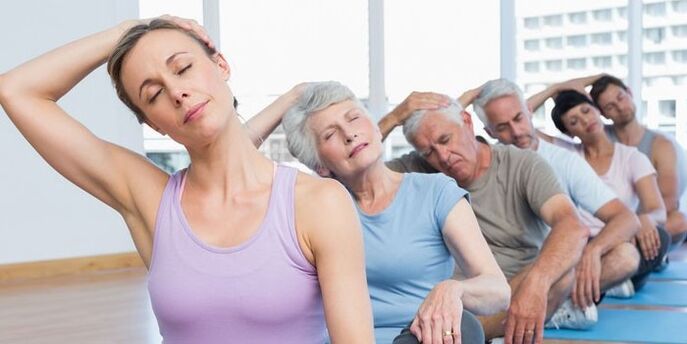Sedentary work, spinal cord injury, being overweight - there are many reasons why osteonecrosis (dystrophic disorder in the discs) develops. The pathological process develops over the years, gradually causing you to feel numbness in your hands, burning between your shoulder blades, neck pain and other uncomfortable symptoms. You can help yourself if you start exercising at the right time.
Benefits of exercise therapy for cervical spondylosis
Recently, cervical osteosarcoma was considered an age-related disease, but today the disease has become much younger and can be seen even in patients 20–30 years of age. It is not possible to completely get rid of dystrophy, but well-chosen treatment will significantly improve the patient's quality of life. One of the leading sites in the treatment of osteonecrosis is the physical and therapeutic culture (LFK) complex. Simple exercise has many benefits:
- They help strengthen the muscular corset, increase muscle tone and elasticity of the ligaments, thereby significantly reducing the load on the spine.
- Regular exercises help relieve neck pain, headaches, burning sensation between the shoulder blades.
- Exercising with the cervical spine will activate blood flow, reduce the chance of stroke, and increase oxygen supply to the brain.
- Classes in the early stages allow you to stop the progression of dystrophy, improve posture.
Indications and contraindications
Charging by osteoclast is prescribed during the period of remission, when the pain is relieved. It helps to reduce exacerbations, prevent the development of repeated attacks, complications and further destruction of the joints. Patients with mild spinal cord injury, diabetes mellitus, arterial hypertension should perform the prescribed exercises on a mild regimen and at first only under the supervision of a physician or trainer.
You should not start exercising immediately after eating, on an empty stomach, or after working too hard. Physical therapy exercises are also contraindicated in the presence of the following medical conditions:
- arterial hypertension;
- arrhythmia, tachycardia;
- glaucoma, severe myopia;
- diseases of the vestibular apparatus, accompanied by impaired coordination;
- infectious lesions of the spine;
- exacerbation of osteonecrosis;
- aortic aneurysm;
- post-infarction status in the early rehabilitation stage;
- severe spinal injury;
- acute respiratory viral diseases.

Enforcement rules
Before starting to exercise with cervical osteopathy, it is helpful to familiarize yourself with the general rules of gymnastics:
- Exercise must be done in a well-ventilated area.
- Training clothes should be loose, do not restrict movement and do not bring discomfort.
- Before going to class, you should measure your pulse and pressure, in case they increase, refuse to perform the exercises.
- To reduce the risk of injury, all movements should be performed in a rhythmic manner, gradually increasing the load, intensity and number of repetitions, maintaining the same posture.
- Should regularly exercise sports with genital warts on the cervix. Many exercises are suitable to perform at work, when studying.
- If during exercise therapy, you feel sharp pain, dizziness, begin to feel nauseous, immediately stop doing more and sit down to rest. In the future, reduce your load and consult your doctor.
- In addition to exercises, courses of massage therapy, physiotherapy may be prescribed.
Exercises to cure cervical spondylosis at home
Gymnastics involves performing a series of simple exercises. With your doctor's permission, they can be performed at home with relaxing music. The main condition is that the spine should be as even as possible, should not lie down, but practice standing or sitting on a chair without a back. For a lasting therapeutic effect, exercise every day at the same time.
Start up for what?
An important part of any physical activity is preparing the muscles. A light warm-up will help avoid injury, warm up the muscles, prepare the body for an intense workout, improve blood circulation and stretch the muscles. Sample exercise set:
- Sit in a chair with your back straight, relax, and lower your arms along your torso. Perform a circular motion with your shoulders, first forward, then back. Do 5-10 reps on each side.
- Keeping the position, extend your arms parallel to the floor. With an inhale, bend your elbows, lightly touching your shoulder with your fingertips. With an exhalation, return to the starting position. Make 10 extensions.
- Stand up straight, place your palms on your shoulders, elbows parallel to the floor. On a count of one or two, begin alternating circular motions with your elbows. First, with your right hand, reach the end of the circle, connecting your left elbow. Do 5 rounds for each hand.
- Perform the starting position, as for the first exercise. Clenching your arms, begin to move your shoulders back and forth. Repeat the process 10 times on each side.
Isometric exercise for neck with osteonecrosis
This complex involves performing all exercises without moving the head or neck - only with the help of muscle tension. Gymnastics for the treatment of cervical spondylosis is considered the safest, therefore, it is prescribed to patients for pain relief during exacerbations of the disease. All exercises are performed from one position: standing or sitting on a chair without a back. The duration of a mission is 5 seconds, the number of approaches is 2–5. Examples of effective exercises:
- Lock your fingers together and place your palm on your forehead. Start pressing your hands to your forehead, like trying to tilt your head, supporting your neck muscles to keep your body still.
- Move your hands in the same position behind your head. Press with your palm, making a small forward motion of the head. At the same time, support the arm with the muscles of the neck and forearm.
- Place your right hand on your cheek with the palm of your hand. Press your hands to your face, trying to tilt your head to the left. At the same time, tighten the muscles, do not let the head hang down. Do the same exercise with your left hand.
- Stand up, feet shoulder width apart. Bring your hands to the side, palms facing out. Squeeze the muscles in your neck, arms, and back. Squeeze your elbows together and then step back, trying to get your hands behind your back as far as possible. Carefully bring and straighten your elbows, without straining your muscles, and for balance.
active fitness
Physical education in cervical spondylosis necessarily includes exercises aimed at strengthening and increasing muscle tone of the upper extremities, neck, shoulders and lower back. This is what dynamic tasks are for. All of them are done at a fast pace, with 10-15 seconds rest between sets. You should know that dynamic gymnastics is contraindicated in exacerbations of osteonecrosis, diabetes, spinal cord injuries and cardiovascular diseases.
Set of approximate exercises:
- Stand up straight, bend your legs, place your hands on your waist. Gently tilt your head, trying to reach your shoulder with your ear. Do 5-6 repetitions on each side.
- Sitting or standing, slowly bring your hands up, palms together. As you exhale, slowly return to the starting position. Do 10-15 repetitions.
- Stand up, spread your legs wide, and lower your arms along your body. Perform shoulder spins simultaneously without raising your arms. Do 15 circular movements in 3 sets. To make it more complicated, you can do alternating circles - first with the left, then with the right shoulder.
- Standing, pull your right hand behind you, and at the same time raise your left hand. Do 10 repetitions and 3 for each limb.
- Standing, lower your arms along your torso. Alternately perform side-sliding strokes, raising the shoulders as much as possible. Do the task for 1 minute, then take a break and do 2 more sets.

Practice exercises to cure cervical spondylosis
Many patients of the rehabilitation doctor with the support of exercises for the neck get rid of high blood pressure, osteonecrosis and other health problems successfully. The doctor claims that his physical education improves blood circulation, develops the muscles in the neck and upper spine, and prevents the development of heart attacks and strokes. Exercises for cervical spondylosis will be useful in the rehabilitation period after surgical or traumatic interventions and for people with the following pathologies:
- hypertension;
- drowsiness or insomnia;
- chronic migraine;
- memory decline.
The author of the technique recommends that all exercises be performed from a sitting position. It is important to keep your back as even as possible and not to rush it, otherwise you will not only not achieve satisfactory results, but will also make the condition worse. To monitor your posture, at the beginning, do the program in front of a mirror. The training program is as follows: the first two weeks - every day, then 3-4 training sessions per week.
Exercise therapy for cervical spondylosis has certain contraindications. Fitness cannot be done with:
- elevated body temperature, general malaise, weakness;
- exacerbation of osteonecrosis;
- cancer;
- herniated disc;
- during pregnancy;
- infectious and viral diseases;
- risk of internal bleeding.
7 exercises for neck and shoulders
The complex consists of seven tasks, which must be performed while sitting in a chair with no back or any other hard surface. All exercises for the treatment of cervical spondylosis are shown in the table below:
| Exercise name | Original location | Basic steps | Number of repetitions |
|---|---|---|---|
| spring | Sit in front of a mirror, arms down along the body, head straight. | Pull your chin into your neck as much as possible. Hold for 20 seconds, then gently pull your chin forward and up. After 20 seconds, return to the starting position. | five |
| Metronome | Sit in front of a mirror, arms down along the body, head straight. | Bend your head to the right as far as possible. Lock position for 10 seconds. Slowly return to the starting position and repeat on the other side. | five |
| Look at the sky | Same | Keep your head straight, chin parallel to the floor. Gently turn your head to the right, stay in place for 10 seconds. Return to the beginning and repeat on the other side. | five |
| goose | Sit, arms along body, chin extended forward. | From the starting position, gently turn your head to the right and lower, trying to touch your shoulders with your chin. Hold for 10 seconds, then repeat on the other side. | 6 |
| Frames | Sit, right palm on left shoulder, elbow parallel to the floor. | Bring your chin to the shoulder of your right hand. Hold the position for a few seconds. Go back to the beginning smoothly. Repeat the same for the reverse side. | five |
| Fakir | Hands above head with palms interlaced. | Turn your neck to the left, keeping your chin straight. Hold for 10 seconds, return to the start. Repeat the exercise for the left side. | 7 |
| heron | Sit in a chair with your back straight. | Straighten your arms, palms facing the floor. Pull them back while pulling your chin forward. Hold the pose for 20 seconds. | 4 |
Efficacy and results of treatment
Exercise therapy for cervical spondylosis helps to improve the course of the disease in a short time, with continuous effectiveness, it will cure spinal tumors without drugs. It is not necessary to immediately perform the entire wellness complex of the proposed exercises, beginners can choose the ones given without much effort and gradually increase the volume. After achieving the therapeutic effect, you must not stop exercising, the improvement of the condition must be maintained continuously.
In the absence of strict contraindications, you can stretch the spine on the crossbar. Such exercises help put the discs in the right position, increase vitality, strengthen muscles. Suitable for swimming, dancing, light gymnastics, yoga or aerobics. To prevent bone necrosis and make a full recovery, doctors recommend maintaining an active lifestyle and organizing a reasonable workspace.


























